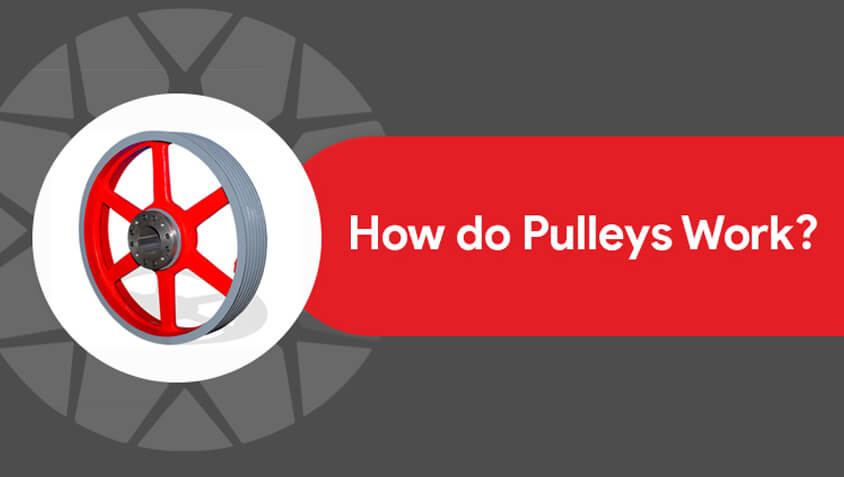Introduction
Simple Machines were developed by people to reduce the efforts required for a particular work. For lifting a particular object of certain weight, an equal amount of force has to be applied in opposite direction. For example, to lift box weighing 10 kilograms, a 10 kilograms equivalent force has to be applied in upwards directions. This is a bit tiring as the force has to be applied against the gravitational force. As a result, pulleys were invented as simple machines used to lift or pull an object with reduced effort. Let us discuss the processes of how pulleys work in a more detailed manner.
What are Pulleys?
Pulleys are considered as one of the basic simple machines that have been discovered which are used to lift objects. The first use of pulleys was done by people of the ancient Egyptian and Mesopotamian Civilizations. Pulleys are made out of a combination of wheel/wheels fixed to a shaft or axle. These wheels are thick and contain grooves in the central portion to allow free movement of ropes or cables around it without any resistance.
Image: A single pulley with a rope fixed with an axle
Multiple pulleys are often placed together in a single system to reduce the effort being used to lift or pull a specific object. An increase in the number of pulleys reduces the manual effort required.
Image: Multiple pulleys placed together to reduce the effort
As shown in the image above, multiple pulleys reduce the effort required to lift a load. The load here has a weight of 100N, and the force that has to be applied is 33.5N. Let’s go through elaborated details of how do pulleys work.
How do pulleys work?
Pulleys are used in multiple sectors of works that are associated with lifting and pulling of certain objects that have increased mass or weight. As the name suggests, Pulley has been derived from the word Pull. As stated earlier, pulleys are fixed at an axle in the central portion of the wheel to allow free circular movement around it. The wheel has a groove in it so that a rope or cable can be placed. The rope or cable is pulled at one end so that the load can be lifted or moved in the desired direction. Let us focus on a few systems in which pulleys can be used.
How do one wheel pulleys work?
One wheel Pulley systems contain the use of only one pulley around which the rope is placed. In such cases, the load is either fixed at one end of the rope, or the load is attached to the axle of the pulley.
– Lifting an object with the help of one wheel Pulley system (Load attached to the rope)
Image: Single Fixed Pulley System
As shown in the image above, a load of 100 pounds is attached to one end of the rope. The rope passes through a single wheel pulley system and reaches the other side. Typically, if a person manually lifts the weight, he/she has to exert a force in the upward direction (against Gravitational Pull of Earth) in order to lift it. This will be against the Gravitational Force that is present on Earth. However, with the help of a pulley, the direction in which the force is applied is changed. As a result, the effort required to lift the object is reduced (as the force is being applied towards Earth). If the rope is pulled by 1metre, the weight is also lifted by 1metre as the length of the rope is fixed.
Important Note: In the case of a single fixed pulley, the tension force working on the entire rope is the same as the mass of the object in Newton.
– Lifting an object with the help of one wheel Pulley system (Load attached to Pulley)
Image: Single Movable Pulley System
A single fixed pulley has a mechanical advantage of 1 because the effort (force) applied is equal to the mass lifted. However, in the case of a single movable pulley, the mechanical advantage is 2. This is mainly because the effort (force) that has to be applied is half of the mass that is to be lifted.
A movable pulley has the load attached to the axle or shaft and one end of the rope or cable is fixed. The other end of the rope is pulled in the same direction as the weight. The entire pulley moves around the rope as the weight is lifted. As one end of the rope is fixed to a solid structure and the pulley hangs in between both sides of the ropes bear the force of the load. As a result, the mass of the object is halved, and only half force has to be applied to lift the object.
Important Note: In the case of a movable Pulley system, the tension force working on the rope at either side is half of the mass that is being lifted. Thus if an object of ‘M’ mass is being lifted, the tension on each side of the rope is M/2.
How do two wheel pulleys work?
The increase of wheels in a Pulley system helps in the reduction of effort that is required to lift the load. Mechanical advantage is gained with an increase in the number of wheels in a pulley system. Mechanical advantage is the ratio of the amount of weight and the number of sections into which the rope is divided. A pulley with two wheels is usually placed in mainly one combination where one pulley is fixed, and another pulley is movable.
Image: Two Wheel Pulley System
Using a two wheels pulley system is almost similar to using a single movable pulley as the same mechanical advantage is gained. However, there are two main differences in this case:
- Firstly, the force is applied downwards to lift an object upwards. This helps in negating the Gravitational Force acting on the load.
- Secondly, in order to lift an object by distance x, the rope has to be pulled by distance 2x. This is mainly because the rope is now divided among the two pulley systems and has two tension sections. Each section of the rope has to be moved in order to lift the weight. Thus a move of x distance in each section of the rope will lift the load by x distance. In order to move both the rope sections by x distance, an equivalent length of 2x portion has to be pulled.
-
How do four wheel pulleys work?
Image: Four Wheel Pulley System
In the case of a Four Wheel Pulley system, there is a further reduction in the effort that is required to lift an object. This is mainly because the rope is looped four times around the pulley system, ignoring the free end that is being pulled down. As a result, the mass of the object or the force acting downwards through the load is divided by four times. As a result, a person who is pulling the free end of the rope has to apply only one-fourth of the force to lift the object. However, to lift the object by a distance x, an equivalent length of 4x has to be pulled by the person on the rope.
Conclusion
Pulleys are one of the most widely used simple machines in various industrial and mechanical sectors. Development with time has increased the effectiveness of pulleys. Designing has allowed people to gain the mechanical advantage of the four pulleys system by using only two pulleys by simply increasing the number of grooves in a single pulley. To know more about how pulleys work visit the website of Pulley India and get detailed information.







